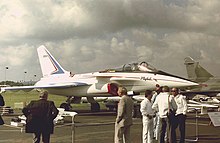 |
|
| A French Air Force Dassault Rafale B at RIAT in 2009 | |
| Role | Multirole fighter |
|---|---|
| National origin | France |
| Manufacturer | Dassault Aviation |
| First flight | Rafale A demo: 4 July 1986Rafale C: 19 May 1991 |
| Introduction | 18 May 2001 |
| Status | In service |
| Primary users | French Air and Space Force French Navy Egyptian Air Force Indian Air Force |
| Produced | 1986–present |
| Number built | 259 as of 2023 |

Many of the aircraft's avionics and features, such as direct voice input, the RBE2 AA active electronically scanned array (AESA) radar and the optronique secteur frontal infra-red search and track (IRST) sensor, were domestically developed and produced for the Rafale programme. Originally scheduled to enter service in 1996, the Rafale suffered significant delays due to post-Cold War budget cuts and changes in priorities. There are three main variants: Rafale C single-seat land-based version, Rafale B twin-seat land-based version, and Rafale M single-seat carrier-based version.
 The Dassault Rafale A technology demonstratorThe Rafale B was initially expected to be just a trainer, but the Gulf War showed that a second crew member was invaluable on strike and reconnaissance missions. The Air Force therefore switched its preferences towards the two-seater, and planned that the variant would constitute 60 percent of the Rafale fleet. The service originally planned to order 250 Rafales, later reduced to 234 aircraft, 95 "C" and 139 "B" models", and then to 212 aircraft. The Navy originally planned to order 86 Rafales, which was reduced to 60 by to budget cuts, 25 M single-seaters and 35 two-seat Ns. The two-seater was later cancelled.. The Dassault Rafale A technology demonstratorThe Rafale B was initially expected to be just a trainer, but the Gulf War showed that a second crew member was invaluable on strike and reconnaissance missions. The Air Force therefore switched its preferences towards the two-seater, and planned that the variant would constitute 60 percent of the Rafale fleet. The service originally planned to order 250 Rafales, later reduced to 234 aircraft, 95 "C" and 139 "B" models", and then to 212 aircraft. The Navy originally planned to order 86 Rafales, which was reduced to 60 by to budget cuts, 25 M single-seaters and 35 two-seat Ns. The two-seater was later cancelled.. |
Ceiling
MAX RANGE
Aircraft Speed
Max Crew


Initial deliveries of the Rafale M were to the F1 ("France 1") standard, which were equipped for the air-to-air interceptor combat duties, but lacked any armament for air-to-ground operations. The F1 standard became operational in 2004
The Rafale was developed as a modern jet fighter with a very high level of agility.
The Rafale's glass cockpit was designed around the principle of data fusion—a central computer selects and prioritises information to display to pilots for simpler command and control